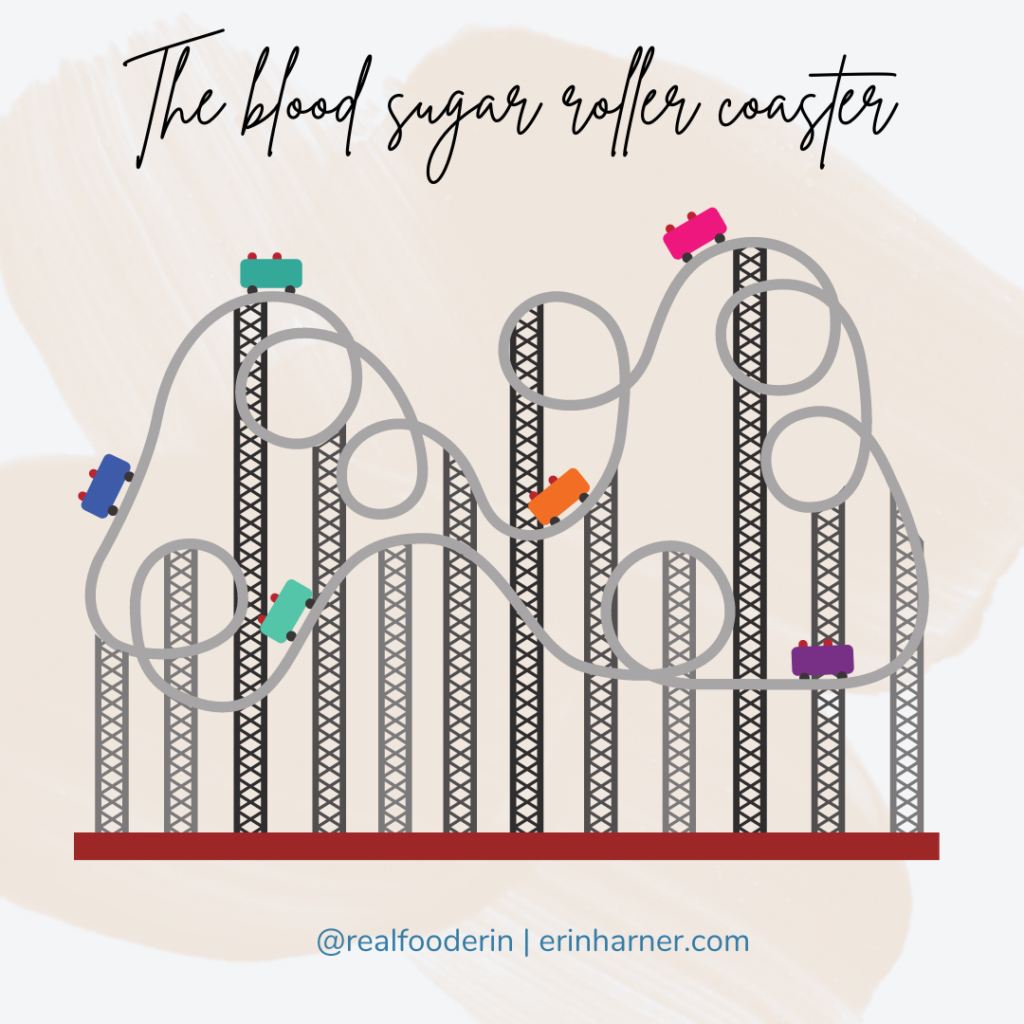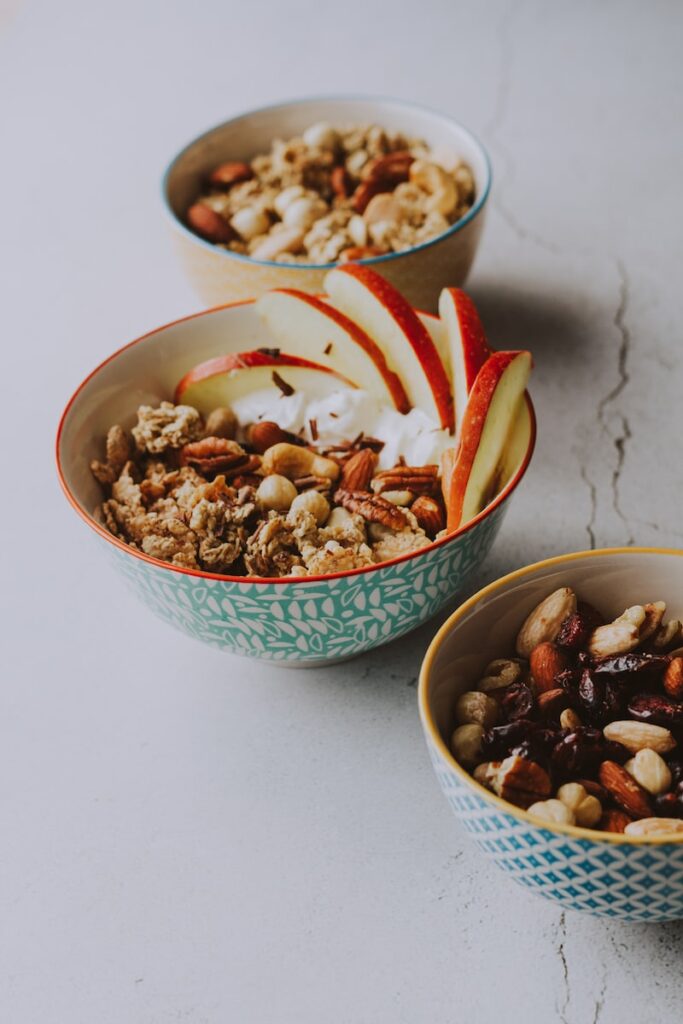When you eat carbohydrates (basically foods made up of sugars and starches) the sugars from the meal get absorbed through your GI tract and enter your bloodstream. Your blood sugar rises and your pancreas releases the hormone insulin. Insulin allows your cells to pull sugar from your blood to use as fuel, which lowers your blood sugar.
When you eat a high carbohydrate meal, dessert, or snack, your blood sugar will rise quickly after you eat creating a “blood sugar spike”. What goes up, must come down, so blood sugar spikes result in the release of lots of insulin (sometimes too much) and are often followed by your blood sugar crashing. When your blood sugar goes high up and low down over and over again throughout the day, we functional nutritionists call this the blood sugar roller coaster. Long-term these blood sugar swings negatively affect hormone balance, weight, mood, and your immune system.

So, what can you do to stabilize blood sugar and prevent the blood sugar roller coaster?
To stabilize your blood sugar, combine carbohydrate-rich foods with foods containing protein, fat, and fiber. Protein, fat, and fiber all slow down the absorption of carbohydrates which helps prevent blood sugar high-highs and low-lows. Your blood sugar naturally rises after eating but you can prevent it from going too high and too low by eating protein, fat, and fiber rich foods at meals and snacks. Also, when you’re deciding which carb-rich foods to eat, aim for complex carbs or whole foods over processed and refined carbs.
For example, go for brown rice over white rice when you can because the brown rice contains more fiber, protein, fat, and nutrients than the white rice. They are actually the same grain- the difference is the white rice was stripped of the outside bran and germ and the starchy center called the endosperm is what’s left after processing.
Some foods rich in fat, fiber, and/or protein are:

- Nuts like almonds, walnuts, etc. (high fat, high fiber, moderate protein)
- Seeds like pumpkin, sunflower, chia, flax, etc. (high fat, high fiber, moderate protein)
- Nut butters and seed butters (high fat, high fiber, moderate protein)
- Beans and lentils (high fiber, high protein)
- Vegetables, fruits, and leafy greens (high fiber)
- Whole grains like brown rice, quinoa, buckwheat, millet, oats, etc. (high fiber)
- Whole grain products like breads, muffins, etc. (moderate fiber)
- Avocados (high fat, high fiber)
- Meat, fish, poultry, eggs (high protein)
- Full fat dairy products like yogurt, cheese, cottage cheese, etc. (high fat, high protein)
How do you stabilize your blood sugar with protein, fat, and fiber?
Eat meals and snacks containing protein, fat, and fiber! Here’s some ideas to get you started:
- Snacks- think produce + protein/fat
- Apple and almond butter
- Pear and cottage cheese
- Carrots and hummus
- Bell peppers and black bean dip
- Avocado and hard boiled egg salad
- Trail mix with nuts, seeds, and some dried fruit like apricots, cherries, raisins, etc.
- Meals- think produce + protein + fat + high fiber carb
- Salad greens and chopped baked chicken and EVOO-based balsamic vinaigrette and quinoa
- Chili with bell peppers, tomatoes, kale, and beans topped with some avocado and a piece of cornbread on the side
- Coleslaw with dressing (fat), meatballs (black bean, turkey, or meat), over whole-grain pasta (size of fist)
- Desserts- use this same principle for some delicious sweet treats containing protein, fat, and fiber that will stabilize your blood sugar and not spike it
- Chia pudding made with fruit like Strawberry Dream Chia Pudding
- Energy balls with nuts like Chocolate Chip Cookie Dough Balls
- Desserts or muffins made with nut flours like Hearty Apple Cinnamon Muffins
- Treats made with high fiber whole grains like Berry Oat Bars
- Pudding made with fat, fiber, and protein-rich ingredients like Blueberry Lemon Tapioca Pudding
Bottom line, keeping your blood sugar stable is important during the holidays (just like it’s important the rest of the year too). Be sure to include protein, fats, and/or fiber at every meal to help stabilize your blood sugar and aim for whole food carbohydrates versus processed carbohydrates whenever possible.


Thanks Erin: I am on a keto diet, but now I have to increase fruits and vegetables so that I don’t stress my kidneys. Because I now have two stents (will be getting more for the other coronary artery) I am taking Birlenta which ups my creatinine levels so I have to also be aware of what this is doing to my kidneys. Your blog is very informative. Cheers John
Thanks for sharing John. All the best to you! I know you know this but I want to reiterate for others reading that it’s really important if you have specific health conditions or concerns to work with a qualified health professional who truly understands the full body systems to support you. Fat, fiber, and protein is a general recommendation that is really helpful for many, not all. For example, too much protein can stress the kidneys. Fiber rich foods behave differently in different guts, etc. -Erin